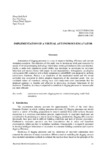Vui lòng dùng định danh này để trích dẫn hoặc liên kết đến tài liệu này:
http://thuvienso.bvu.edu.vn/handle/TVDHBRVT/19074Toàn bộ biểu ghi siêu dữ liệu
| Trường DC | Giá trị | Ngôn ngữ |
|---|---|---|
| dc.contributor.author | Park, Hong Seok | - |
| dc.contributor.author | Dang, Duc Viet | - |
| dc.contributor.author | Nguyen, Trung Thanh | - |
| dc.contributor.author | Le, Ngoc Tran | - |
| dc.date.accessioned | 2018-08-01T01:47:52Z | - |
| dc.date.available | 2018-08-01T01:47:52Z | - |
| dc.date.issued | 2017 | - |
| dc.identifier.issn | 1849-1391 | - |
| dc.identifier.uri | http://thuvienso.bvu.edu.vn/handle/TVDHBRVT/19074 | - |
| dc.description | 16 pp. | vi |
| dc.description.abstract | Automation of digging processes is a way to improve building efficiency and prevent workplace accidents. The objective of this study was to develop an intelligent excavator by means of virtual prototyping technology which takes working disturbances into consideration. Firstly, a multi-body simulation model (MBS) was developed to investigate the excavator behaviour and reaction forces with respect to soil characteristics. Subsequently, an adaptive sliding-mode PID controller with a fuzzy compensator (ASMPIDF) was proposed to perform autonomous functions. Finally, a co-simulation of the mechanical model and the virtual controller was conducted to derive adaptive trajectories of the excavator joints. The low simulated values of overshoot, settling time, and steady-state error demonstrate that the proposed approach is feasible and effective in developing intelligent behaviours of the excavator. Therefore, this study is expected to contribute to digging processes to become safer and more efficient | vi |
| dc.language.iso | en | vi |
| dc.relation.ispartofseries | Transactions of famena XLI-3 (2017);tr. 65-80 | - |
| dc.subject | Autonomous excavator | vi |
| dc.subject | Digging process | vi |
| dc.title | Implementation of a virtual autonomous excavator | vi |
| dc.type | Article | vi |
| Bộ sưu tập: | CNTP-KTHH - Xây dựng (Articles) | |
Các tập tin trong tài liệu này:
| Tập tin | Mô tả | Kích thước | Định dạng | |
|---|---|---|---|---|
| Le-Ngoc-Tran.pdf | 5,91 MB | Adobe PDF |  Đăng nhập để xem toàn văn |
Khi sử dụng các tài liệu trong Thư viện số phải tuân thủ Luật bản quyền.